By Deborah Shapley
Martha Betz Shapley was known as First Lady of the Harvard College Observatory during the 32 years her husband Harlow was its Director. “The friendship and hospitality she extended to members of the Harvard astronomical family…was one of the highest experiences of my younger days,” wrote Leo Goldberg on her death in 1981. /1
She welcomed scared new graduate students, faculty, staff and guests. Her household was enlivened by a busy husband and five children. She was a fine pianist who made music part of Residence life. HCO became a “mecca for astronomers from around the world” in the Shapley years. See Close-up: Life with the Director
You could say that Martha Shapley helped astronomy as hostess and wife. You could add that she contributed as an astronomer herself, though she might deny herself the high title.
Today Mount Wilson Observatory is highlighting the women who contributed to its work since 1904 when George Ellery Hale built the first solar telescope on the 5,700-foot mountain and headquarters on Santa Barbara Street in Pasadena. /2
Much is known about Harlow Shapley’s work at Mount Wilson after he arrived in 1914. In nineteen startling papers on the structure of the sidereal system, Shapley discovered the true shape of our galaxy with the world-beating 60-in optical telescope which Hale had built in 1908. Shapley mapped a huge, watch-like shape for our galaxy, with a fat center and our solar system near the edge. The papers are classic works debated then and since for how he was (and is) right and where he was wrong.
A previous Shapley paper in 1914 demonstrated that Cepheids are not orbiting double stars but single stars whose light varied due to pulsation. Before that Shapley published his Princeton PhD thesis on eclipsing binary systems. The vast data he provided on different spectral types of stars showed that they evolve. Thus he provided evidence Henry Norris Russell needed for his famous Diagram of stellar evolution. There are accounts of Shapley’s undergraduate work at the University of Missouri 1906-1910 for Frederick H. Seares who led him into astronomy in the first place.
But what of Martha? They met as students at the University of Missouri. They married in 1914 and took the train to Pasadena and Mount Wilson. I decided to research her role from curiosity about a beloved grandmother and to highlight more of the contributions of women to astronomy.
Martha Betz Shapley with Willis and Mildred, likely taken in 1918, the year Harlow Shapley’s most important papers were published. Martha authored and co-authored fourteen papers from 1915 through 1922.
Photo: Shapley-Matthews Collection
I knew she had done some astronomy in their Harvard years. And that she had a job computing ballistics for the military during World War II. A later article in this series will take up this phase of her life.
She left few records. She was not self-important; not the type to save letters. Her files and work papers are just a few of the 167 boxes of Harlow Shapley Papers at Harvard University. /3
My research found a surprise. From 1915 - 1921 Martha published several papers of her own; she was also Harlow’s co-author; he credits her in the text of some of his “great papers” series. Maybe Martha could have continued a full astronomy career and as a mother of five. But her husband’s scientific activity and fame exploded so their lives took unexpected busy paths.
I - BREMEN TO KANSAS CITY
II - HARLOW’S 1914 PAPERS
III - MARTHA’S PAPERS & CREDITS
IV - WOMEN AT MOUNT WILSON
V - GALLERY - ECLIPSING BINARY STARS
I - Bremen to Kansas City
My source for the family and Martha’s early years is “The Home Life of Carl Betz and Louise Wittig Betz,” a hand-written booklet by her sister Annette (Nettie) Betz she wrote in 1981 on Martha’s death at 90. The best online bio is Martha Betz Shapley on MacTutor. /4
Their father Carl Betz was prominent in the German community in Kansas City. He was a pioneer in physical education for which he received a silver medal at the 1893 Columbian World’s Fair in Chicago for this. He composed and taught music, “sang beautifully” and played the cello. He had helped establish the hospital where he died suddenly of appendicitis at 43.
Annette Schurmann Wittig was born in Germany in 1840. In 1923 she came to live in the home of her daughter Louise Betz. She died in 1944 at age 104.
Credit: Shapley-Matthews Collection
Betz Family ca 1899. Martha age 8 is the girl on far right. Girl on upper right is Annette (Nettie). L to R Mother Louise Wittig Betz holding baby Louise. L to R below Alma, Eggmont and Carl William. Credit: Betz-Wittig Genealogy.
Carl’s death left Louise a widow with six children plus a baby born a few months later. Nettie was in charge of the household when she came home after school so “our mother could…go out and give German lessons.”
Skipping first grade, playing the marches
Only German was spoken at home. When Nettie arrived to start school “I knew not a word of English.” She brought her First Reader home each night so Alma (two years younger) and Martha (four years younger) could figure out the English. Later when Martha started school, the teacher discovered she was reading Louisa May Alcott’s Little Women. “They put her in the second grade!”
Music was played at home; Martha learned the piano. Nettie reports that at the end of recess at school, the students lined up and marched to their classrooms. Martha played the marches. In high school she continued German study and added Latin, getting through Caesar, Cicero and Virgil. Martha and Alma graduated in 1906 at the head of the high school class.
When I read Nettie’s slender, moving account, bits of Martha’s biography seem to foreshadow her later life and maybe prepared her.
Martha’s grandfather John G. Betz was born in Germany in 1816. He told her that as a boy in Hannover he had seen the great astronomer Caroline Herschel driven in her coach through the town. John Betz married a German woman of aristocratic descent; they emigrated in 1863 (she in 1864) and moved to St. Paul, Minn. where he became a civic leader. Their son Carl Betz in Kansas City carried on the tradition of learning. He showed his flock of children chemical experiments, constellations and one summer a comet. On Thursdays they went to concerts in the local park. The three older girls memorized Shakespeare while their little brothers acted out the exciting parts.
Of the home: The little brothers took over the house’s basement for a “boys’ club” and local kids came over. There was a punching bag and phonograph. The basement shelves of books became a lending library.
Of their mother Louise: “She was a good manager, always had complete control without arguments, and without any outward show led us in the right direction. Besides taking care of the necessities of life, she knew how to make things interesting.”
Of visiting lectures: From about 1906 when Martha was at home & teaching, “Mother and we older girls were charter members of a group that brought university professors to Kansas City for lecture series.”
“Martha taught [in Kansas City for] three years.” She went to the campus for summer school and for her senior year at the university. Like many women students, she boarded with a family in Columbia in exchange for domestic work. She graduated Phi Beta Kappa in 1910. /5
Love letters in Gregg shorthand
In a math class Martha caught the eye of another student Harlow Shapley. She was likely 19. He was 24, having started college late. His farming family could not afford college so he had worked as a newspaper reporter to save up.
Harlow could call on her while they were both on campus in 1907-1911. He could take the train from Columbia to Kansas City to meet the Betz family. They were charmed by his stories.
"In my third year I met a brunette named Martha Betz, from Kansas City, and never got loose, or wanted to. We first met in a mathematics class--she sat in the front row and knew all the answers." - Harlow Shapley .
He told Martha he would learn her language, German, if “you learn my language” Gregg’s shorthand - a speed writing system popular at the time. They would raise their children speaking German in the home and dashing off letters and cards in Greggs to each other and anyone else who could understand it. /6
University of Missouri Yearbook, Class of 1910. Harlow Shapley and Martha Betz entries. Credit: Harvard University Archives, Harlow Shapley Papers.
Did she take an astronomy class? Not needed, she told their daughter Mildred later. “I had an extracurricular private tutor.”
Nettie writes: “They liked to work things out together. One Sunday some years later, when Harlow was calling on Martha at our house in Kansas City, they translated an astronomy article from Chinese into English!”
She continued teaching German and math in Kansas City while doing coursework and a thesis for a master’s in languages which she received in 1912. Harlow had earned his master’s in astronomy at Missouri in 1911. That fall he went east to Princeton to begin doctoral study under the famous astronomer Henry Norris Russell.
Martha applied for a fellowship at Bryn Mawr; it required doctoral study in Teutonic philology. “If similar aid had been available in mathematics, she might have preferred it,” Mildred writes. /7
She was at Bryn Mawr from September 1913 with Harlow a train ride away at Princeton. In January 1914 she resigned her fellowship and went home to Kansas City to prepare for the wedding. Harlow had secured a job as staff observer at the best telescope in the world on Mount Wilson in California. He had proposed; she accepted. She was obviously delighted. Years later she noted a bit ruefully “No PhD.”
In this period Harlow “put finishing touches” on the PhD thesis he had submitted and had accepted in 1913. See II - Harlow’s 1914 Papers Now he looked at what research he might do at Mount Wilson. He visited the Harvard College Observatory and called on Solon I. Bailey; he also dined with Director E.C. Pickering. See III - Martha’s Papers In April he boarded the train to Kansas City, the Betz home and Martha.
He tells of their wedding in his usual topsy-turvy language:
“I made a mess of the formalities, declined to drink the celebrating champagne, and with cousin, Ralph, as best man I marched to the guillotine eagerly - that is double the customary speed… I had never seen a wedding ceremony. It was a quiet homey affair.”
Martha Betz and Harlow Shapley at their wedding in Kansas City, Mo. April 15, 1914.
Photo: Shapley-Matthews Collection
“It was a long trip, but I had some nice observations with me and we worked on the orbits of eclipsing binaries on the honeymoon. Mrs. Shapley was very quick at computing, so we enjoyed ourselves for a couple of days.” '“ We set ourselves a goal of trying to finish certain computations before we hit the Rockies, and of course we did!” /8
II - Harlow’s 1914 Papers
This article is the first to show Martha Betz Shapley’s publications and credits during their seven years at Mount Wilson that began after that train ride.
Yet before she published in her own name, Martha enters astronomy history for her help to Harlow on the doctoral thesis he did under the guidance of Henry Norris Russell. The thesis was published first in September 1913 and in final form in April 1914.
It is hard to overstate the importance of Shapley’s thesis - a catalog of nearly 200 stars that orbit in pairs as eclipsing binaries and of the two-year process that led to it. The project created in a single stroke a new branch of double-star astronomy.
Binaries are a type of variable in which two stars orbit one another. When one in a pair eclipses, or passes in front of, the other the dips and rises of light can be plotted as “curves” for that system, offering rich data on both stars. See graphics at V - Gallery Eclipsing Binaries. Astronomers had been fascinated by these plentiful, sparkling objects for a long time.
In 1911 Russell published a theory of how comparative analysis of the stars in eclipsing pairs might reveal the characteristics of all types of stars. But the literature had 50,000 reports of known or suspected binary systems. David DeVorkin in his biography of Russell quotes him:
“And at that moment the Lord sent me Harlow Shapley.” /9
In the fall of 1911, Russell assigned his new graduate student the task of compiling old and recent observations. It started as “a simple thesis project,” Shapley later said. It grew as he figured out how to find the type, size and density of each star in a pair. There was no simple formula. Russell buzzed in and out of his office, peering at his protege’s latest results.
Russell placed the data into a draft plot of how types of stars can change with the eons. So Shapley’s thesis data made possible Russell’s famous diagram of stellar evolution that he released in December 1913 and published in Nature in 1914.
Hertzsprung Russell Diagram. LEFT: Nature 1914 publication of Russell’s plot of stars by size and spectral type with data compiled by Shapley 1911-1913 . The data showed most stars are in a “main sequence” band. There are other groups such as the giant red stars at upper right.
RIGHT: Russell’s continued work merged with Enjar Hertzsprung’s parallel effort to became the H-R Diagram, a basic tool of astronomy. Credit: Encyclopedia Britannica.
Shapley completed his first version in March 1913. “The orbits of eighty-seven eclipsing binaries -- a summary” appeared in that September. In March Shapley took his oral exams, collected his magna and with Russell’s urging and an allowance, visited observatories in Europe for five months. /10
Zdeněk Kopal was an astronomer who later worked with Martha on eclipsing binaries at Harvard. In a 1986 memoir Kopal “introduced” Martha as the “third, silent partner on the great work of 1912-1914.” He imagined “often, young Harlow would take a train … and meet Miss Martha Betz… who would take over new computations from her fiancé…and deliver those she had already finished..” Versions of this have been repeated. /11
Of course I investigated. The Appendix tells what I found. Briefly:
There were two phases to the project. The first year-and-a half when Shapley classified 87 pairs. (Of 199 stars in all, Shapley did 184 stars, Russell and others did the rest.) Russell plotted their densities and possible age - while Martha was in Kansas City. The second phase was from September 1913, when Martha was at Bryn Mawr, through January 1914, when she returned home to prepare for the wedding. In this interval Harlow, back from Europe, recalled “finishing up details” on the 1914 version of the thesis that covers 90 pairs. /12
So September through January was the happy interval when they were a couple of train rides apart. Martha was starting what she hoped would be her doctorate in Teutonic philology and also doing computations. Harvard Archives has “Notes” Martha made in 1973 after Harlow’s death for memorial texts. She wrote merely dates and “HS” MB” “KC,” etc. She refers to this project once:
“MBS worked on eclipsing stars while at Bryn Mawr + before by mail”
“HS [at] Princeton …finished thesis Jan 1914”
“Resigned Jan 1914, left to KC to prepare for wedding.” /13
Her involvement was later in the process and not decisive in Russell’s sweeping results. She had contributed “by mail” to the results of 1913. She contributed during the second phase. What and how much? Harvard Archives has a few folders labeled “Eclipsing Binaries” waiting for an astronomer who reads Gregg shorthand to decode.
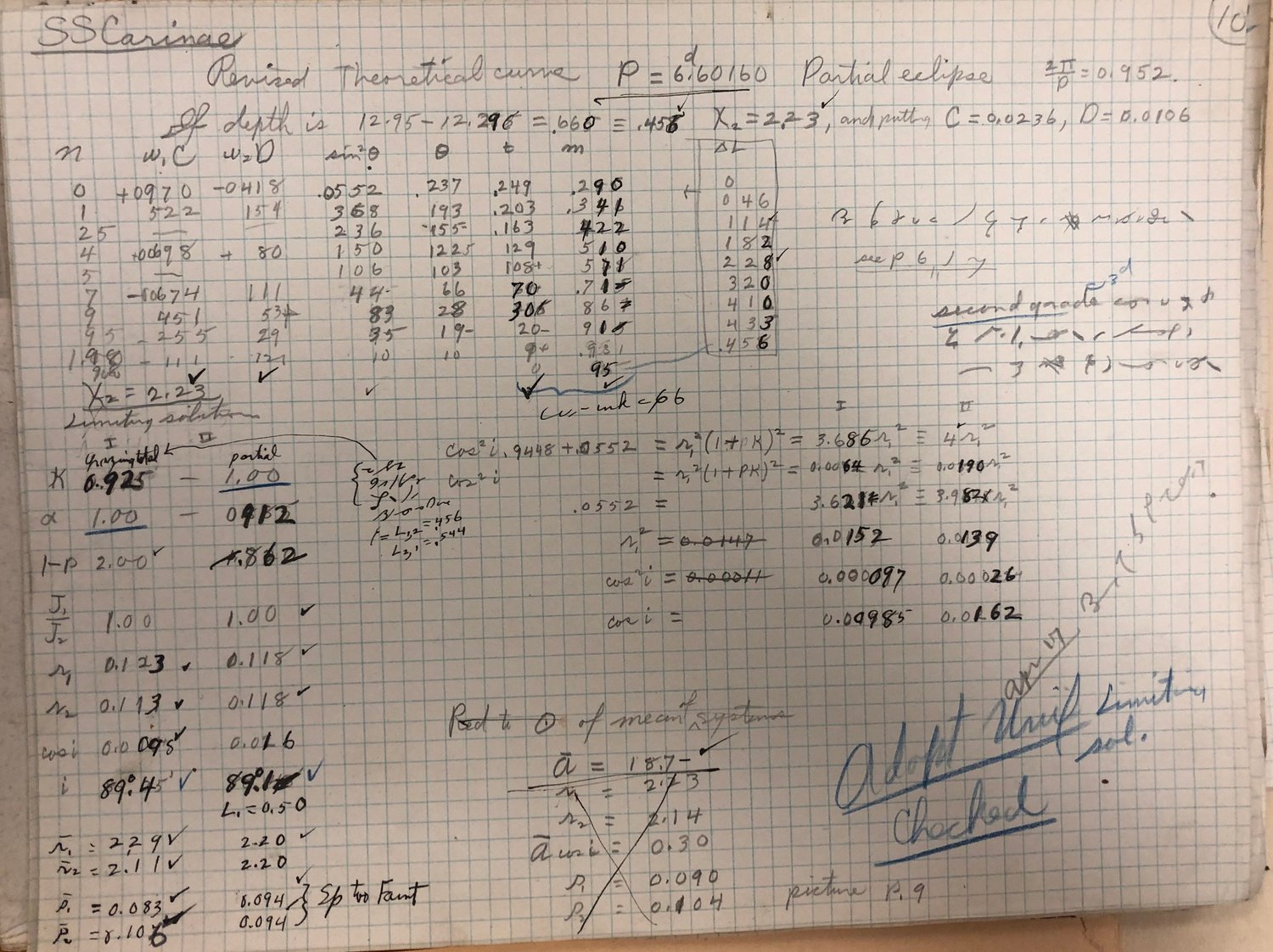
So if Martha contributed to the 1914 thesis, why does he not mention her in the credits?
My grandmother would not have wanted this, I believe. She had no formal qualifications - which were important in the field and to her. She might fear that her name would hurt the credibility of Harlow’s publication. The final thesis credits list astronomers and institutions -- the right pedigree for an important work by a rising star! /14
Cepheids are not binaries but pulsate
Shapley’s August 1914 paper on Cepheids gets less attention in later literature because the uses of Cepheid spectra Shapley proposed were immediately investigated, applied, and became a basic tool - not least by Shapley himself. At the time the 18-page essay clarified a long-standing issue. /15
The Princeton thesis project charted the steady dips and rises in light from eclipsing binaries; it made clear that Cepheid variables do not blink evenly.
The bright big Cepheids were of new interest because in 1912 Henrietta Swan Leavitt of Harvard published her second and conclusive paper proposing that Cepheids’ periods of variation indicate distance. At the time Cepheids were thought to be double stars. Now Shapley calculated that if stars of such size and density were in orbit they would fall into each other.
Since Cepheids cannot be binaries, he asked how do they blink? The light must change due to radial pulsation, by mechanisms speculated about but no one understood. It showed Cepheids could be richer research tools than previously believed. 16/
Later Shapley ranked this 1914 paper and a related one from 1916 as third of his eleven greatest contributions to astronomy. /17
The 1914 pulsation paper is an essay. It does not show tabulations of individual stars or systems, the work on which Martha was gaining proficiency. She is not mentioned in it, but her work on the binaries likely added to it’s findings. Once at Mount Wilson she worked on Cepheids too. See IV - Martha’s Papers & Credits
Four generations of Betz women. L to R: Louise Wittig Betz, Annette Wittig, Mildred Shapley, Martha Betz Shapley. Credit: Shapley-Matthews Collection
III - MARTHA’S PAPERS & CREDITS
During their seven years in Pasadena, their first three children were born starting with Mildred born in 1915. In their small home things must have been lively. Martha worked there, hand-writing and typing computations and text. Harlow did a lot of work at home too - their lifelong habits settled in. The outdoors beckoned: California mountains, parks and beaches were new for them.
House in Pasadena similar to the Shapleys’.
For this article I traced these publications and a bit of their content, aided by astronomy author Jeff Kanipe. The new Martha Shapley Bibliography by Tom Bogdan complements his complete Bibliography Harlow’s publications this site.
Martha’s astronomical work in Pasadena resulted in seven papers under her name. Her Bibliography shows 14 due to the practice of one paper being published in a second journal. See Production.
Though she observed on the telescope, or tried it, she likely spent little time in the huge, cold dome on the 5,700-foot high mountain due to her pregnancies. Also Director Hale had a policy against women working up there. See IV - Women at Mount Wilson
Her published work, collaborations and her husband’s credit mean that to us today Martha Shapley was an astronomer, no matter what she thought (no degree) and the conventions of that time.
Below are Martha’s papers and a bit of their content. To skip go to A Martha Star? Since eclipsing binaries became her life-long specialty V - Gallery Eclipsing Binaries has samples of her early work.
XX Cygni In 1915 she was second author to Harlow on an important 17-page analysis of XX Cygni. It is “the shortest-period variable star known.” They find that “the shape of the light curve varies from cycle to cycle,” confirming Shapley’s 1914 view of Cepheid pulsation.
XX Cygni had been “discovered in 1904 by Madame Ceraski.” (See V - Gallery for more on Mme. Ceraski.) Many years later when a reporter asked Harlow about his early work, Harlow pulled out this paper to show his wife’s participation. /18
U Cephei Martha’s first sole-authored paper in 1916 showed the period of the double star U Cephei. She compares past sets of observations of this object over 33 years by different astronomers. She finds the most recent set by Wendell’s “are the best working formula at present.”
Her study had a Harvard angle. Oliver Wendell was an HCO astronomer who had died. Harlow recalled when he visited HCO in 1914, he dined with Pickering in the Residence dining room with the tall chairs. The Director allowed the young Shapley to request and use Wendell’s data on variable stars. /19
XZ Cygni Martha’s paper on XZ Cygni shows the limits of women observing at Mount Wilson. She analyzed 95 exposures of this fast-pulsating RR Lyrae variable taken on the 60-inch telescope “by Mr. Shapley and Mr. Seares” from 1914 to 1916. If she had worked on the telescopes, it is not mentioned here or in any of the papers. See V Gallery. /20
“She measures plates and works out the light curves … by herself”
Martha’s other paper in 1917 dates back to a visit from Harvard’s Margaret Harwood in 1915. Harwood was established at the HCO. She made a trip to western observatories in June 1915 before taking the additional role of Directing the Maria Mitchell Observatory on Nantucket. We know of the visit through a letter she wrote to Annie Jump Cannon and E.C. Pickering. /21
Harwood was talking about variable stars with Harlow Shapley in the Santa Barbara Street office when the telephone rang. Mrs. Shapley was calling to learn if Harwood would be coming to dinner. The result was a very pleasant evening. Martha is “shy and retiring.” “She plays the piano finely.” She is “a wonderful cook.” Their “three months old baby girl…is also a wonder.”
Margaret Harwood as Director of Maria Mitchell Observatory ~1925. Credit Harwood Collection, USNO
Only afterward as Harlow drove Harwood back to her lodging did she learn that Martha had interrupted her Bryn Mawr studies to marry him and come west. “He has now taught her astronomy so she measures plates and works out the light curves of variables and writes out the discussion by herself.”
TT Lyrae and Y Camelopardalis Harwood sent data from Harvard plates on these two eclipsing pairs. Martha is sole author of a 1917 paper on them, saying the work complements Harwood’s paper forthcoming in Harvard Annals. /22 See V - Gallery
Y Leonis Another of Martha’s sole-authored papers that could have been done at home is on the faint eclipsing binary Y Leonis. She analyses new observations taken on the 60-inch. She finds its range is “nearly a magnitude greater” than what “Shapley” published in the 1914 thesis. /23 See V - Gallery
“Mrs. Shapley … is responsible for large parts of the tenth and twelfth papers.”
1917 was a busy year in the Shapleys’ home. Harlow worked furiously at the Pasadena offices and labs and up on the mountain. His principal ‘computer’ was Helen N. Davis. Papers I to V in his series were published.
Martha gave birth to their second child in March. They named him Willis for Harlow’s father who in 1913 had been struck dead by lightning on his farm.
In 1918 five of Shapley’s Great Papers were published laying out his new model and size for the Galaxy. These are agreed to be the most brilliant and lasting, although some parts were shown “wrong,” that is, disproved by later results.
His daring methods used Cepheids and variable stars in globular clusters to “throw the astronomical plumbline” (as he liked to say) farther than anyone had dared. The papers aroused doubts. But as the texts, charts, and tables rolled off typewriters and pens at Santa Barbara Street and at the Shapley home fame came knocking.
Martha is credited at the start of his “sixth paper” in 1918, “On the determinations of the distances of globular clusters.” /24
“In the accumulation of the observational material for these studies much credit is due Miss Davis for the measurement of large numbers of stars in many difficult cluster fields. She has also assisted throughout in the reduction and discussion of the observations. Mrs. Shapley has collaborated in the treatment of most of the problems and, in particular, is responsible for large parts of the tenth and twelfth papers.”
Official recognition - 1918
“Mrs. Harlow Shapley, who has continued her service as a volunteer assistant, has collaborated with Dr. Shapley in his various stellar investigations.” Carnegie Institution of Washington Yearbook, No. 17, p 188.
Then he lists “Miss Connor,” “Mr. Pease,” “Mr. van Maanen,” “Mr. Adams” and “Mr. Seares.” Shapley’s first three credits are to women including his wife.
Martha was his coauthor on Great Papers XIII and XIV published in 1919. Both were submitted in late 1918. Each was published twice per custom.
In March 1919 she gave birth to their third child, a son they named Alan.
“Paper thirteen” explored the relation between the globular clusters and the galactic plane which is basically the Milky Way’s equator. They find that clusters’ orientation shows the gravitational dominance of the Milky Way.
“Paper fourteen” usefully adds 17 globular clusters to the 69 that were the basis of his computation finding a vast size to the galaxy. Now he can plot the locations of 86 of these objects. He proposes how globular and open clusters are arrayed throughout the galaxy. A big problem was the apparent absence of clusters along the Galactic plane - a region he calls the “zone of avoidance.”
Preprint of Harlow and Martha’s XIII and XIV papers for Carnegie Institution of Washington 1919, which Shapley kept handy on a shelf in his revolving desk. Image: Shapley Collection.
Unfortunately for Martha (and her husband) both papers propose myriad causes for the “zone of avoidance.” They rule out there could be interstellar dusty blocking views of this region. Only in 1930 was dust obscuration measured; Shapley’s galaxy was reassured and downsize6 but still huge. /25
We probably can’t know exactly what Martha contributed to these papers. Harlow’s published texts and correspondence have been analyzed a lot. But the paperwork behind them (if it still exists) has never been scoured for provenance.
A Martha star?
But it was not all work. Particular friends were Alma and Seth Nicholson. The couple met as astronomy students at Drake University; after marriage Alma did not pursue a career. Seth worked on solar problems and planets at Mount Wilson.
Minding the kids Harlow Shapley at the beach with Mildred (center) and Willis (left) ca. 1919. Image: Emilio Segre Visual Archives Shapley Collection.
The Nicholsons had a daughter Mildred’s age and a son. The two fathers took their daughters “to Pasadena’s Brookside Park Sunday mornings to give their wives and baby sons a rest,” Mildred later wrote. “While the daughters played with delicious freedom the astronomers would lie on the grass, talk, and write astronomy.”
Shapley recalled in his memoir that in 1916 the two men observing on the 60-inch “found an object we thought was another new moon of Jupiter.” They computed its orbit; it was just an asteroid. In those days asteroids were named for females in the discoverer’s family.
“We flipped a penny and I won the toss.” He wanted to name it Martha. “But Martha was already in the sky.“ So he named it for Mildred. /26
Production
Martha published 14 papers based on her work in Pasadena. Of her 14 bylines she is sole author on seven. On the other seven she is Harlow’s second author. Five of the 14 are duplicates because papers issued as Carnegie Institution of Washington Contributions were often quickly reprinted by Astrophysical Journal or another journal. See Martha Shapley Bibliography
As for Harlow, my informal count clocks him at 142 papers in the same years, 1915 -1921, including 32 duplicates. His papers include two in 1920 on the thermokinetics of ants which secured his legacy in that field. See Bibliography
IV - WOMEN AT MOUNT WILSON
Experts can compare Martha Shapley’s astronomical career to those of other women at Mount Wilson in 1914-21.
I, for one, am impressed! Martha’s seven papers and 14 bylines, plus Harlow’s text credits of her in four of his Great Papers make her very productive, especially as she gave birth to three children as well.
Growing up, she followed the path expected of a Kansas City girl whose family believed ardently in education. She and her sisters went from public school to the University of Missouri, working to pay the fees. Martha got her degree in education to qualify her to teach. Her sisters Nettie and Alma did the same and were life-long teachers in Kansas City schools.
We know Martha loved math and also the complexity of language. When she applied for a PhD at Bryn Mawr, she would have preferred math but financial support was not offered in math. (We can ask Why not?)
Along had come Harlow, a brilliant witty fellow with a similar background and ambition. He was starting a career in astronomy, which required lots of mathematics. Their partnership let her do what she enjoyed most and to ask and to learn from “my private…tutor” even as he moved from one leading-edge project to another.
What did Mount Wilson offer her? I consulted Eun-Joo Ahn of the University of California Santa Barbara who has written about the first women employed there 1906-1912. I also interviewed author Ron Voller, who learned about women’s experiences at the institution for his books on Milton Humason and Edwin P. Hubble. /27
Martha had no degree in astronomy, unlike Louise Ware, the first ‘computer’ hired by Hale in July 1906, Jeanne Belle Lasby, hired soon after, and Beatrice Mayberry, who was hired in 1920.
She would not consider herself an astronomer, given the company she was destined to keep.
But Voller says: “Astronomy is the study of the stars….You are an astronomer If you are looking at them on a plate, pulling out aspects of stars, variations, comparisons and so on, so you can deduce the evolution of the star.”
“If I’m just looking through the telescope, I’m not an astronomer, just a lucky guy.” /28
Four advantages
She had advantages despite the confinement on women’s roles at the time.
First, Martha Shapley was a gifted mathematician. Many who worked with her noticed this including Harlow. He first noticed “the brunette” in the first row in math class “who knew all the answers.” Some have stressed her brilliance to downplay Harlow’s math, ignoring that he was gifted too. He produced voluminous, high-quality work in a field requiring fast computation done by hand (just slide rules).
“Mrs. Shapley is a good instinctive mathematician,” Harlow would say. /29
“Instinctive” does not equal “better.” A common misbelief is that if one member of a pair is “brilliant” at something the other must be average or worse.
But there are different styles of top-tier mathematicians. Or violinists. Members of a swim team or chess players will note the shadings of one another’s skills. Different nuances of talent make human collaborations successful. A pair of orbiting stars attracted and held by gravity can be different and complementary without eclipsing each other.
Second, Martha happened into astronomy when the field needed her skills. Voller says that the edifice of modern astronomy that we use every day now could not have been built without the vast computational work of the early 20th century. To this I add that Martha could do most of the computation at home!
Third, her precision was likely recognized by Frederick H. Seares, the editor of Mount Wilson’s journal of record the Carnegie Institution of Washington Contributions (CIWC). Hale hired Seares in 1909 from Missouri, where Seares was head of the (small) astronomy department. Seares had spotted the freshman Harlow Shapley, gave him a job, and brought him into the field. 30/ We have no record of it but Seares likely met Harlow’s sweetheart Martha when they were students.
Last but not least, in Harlow Martha had a powerful patron with whom she could ask questions and discuss professional matters any time. Ahn writes, “Computers like [Louise] Ware did not have the autonomy to carry out their own research and did not feature as co-authors in scientific articles unless the papers dealt with methods and techniques.” 31/
Few chances on the telescopes
Yet Martha faced the same limits as other women there. Voller: “It was definitely Hale policy that no women worked on the mountain or… in any research activities.” Ahn notes that the institution was planned with offices and labs in Pasadena and the research - the solar and optical telescopes - a long winding drive away 5,700 feet in the mountain.
There was no place for women to stay on the mountain. The dormitory, library and kitchen were and are called The Monastery. A woman could not do the men’s routine of sleeping in their Monastery room by day, dining together at the formal table, and entering the dome for the night’s work.
I asked Voller to compare their opportunities with those of the women ‘computers’ at Harvard. /32
Mount Wilson Institute staff, wives and computing staff (seated) at flag-raising in front of Santa Barbara Street office April 14, 1917. Credit: Observatories of the Carnegie Institution for Science Collection at the Huntington Library, San Marino, California
Harvard College Observatory women staff in paper doll pose ca. 1918. The entrance to the Residence is in the middle of this panorama photo. Credit: Harvard University Archives
”The computers at Harvard had been working for a generation prior to the advent of women at Mount Wilson in the early 20th century. So at the experiential level they got this enormous head start on the women at Mount Wilson,” says Voller.
Louise Ware was hired in July 1906. “By that time Henrietta Swan Leavitt is already studying the stars nearby that will lead to her breakthrough. Annie Jump Cannon is creating spectral classes for stars.
“Harvard was steeped in the Herschellian school of classification and cataloging.” As Harvard telescopes recorded more swaths of southern and northern skies “this class of subordinate labor was needed, Voller says.
“Whereas Hale was interested in what we call astrophysics: the evolution of a star, our star, the sun.” He founded the Mount Wilson Solar Observatory. This work required the top scientists, men assistants and a few computers.
At Harvard, the computers could go a few steps from their workroom and enter the dome and controls of the 15-in Great Refractor or visit the other telescopes on the hill. They could practice positioning the instrument, preparing the glass plate, push it in, open it to light, repositioning everything, and so on. “If you give them the opportunity to do actual observation, look what happens. You get a Vera Rubin.”
Ban on wives’ employment
Voller: Astronomical work “was considered an inappropriate thing for a married woman to do. The computers were always referred to as Miss. Further, no married women were hired as computers to work off the mountain.
“It was allowed for married women to chose to volunteer - almost always at the service of their husbands -as computers.”
Ahn “has not come across a written ban on wives being employed.” Basically, no married women were hired though she knows of at least one exception. /33
Opportunities to publish
Finally lack of publications and credits to women blocked their advance. Ahn’s paper notes that while Louise Ware worked for Hale, she is not his co-author. Her main work was with Charles St. John. From 1912 - 1922 she was co-author on four of St. John’s publications and his texts referred to “we.” Ahn: “It was up to the astronomer when to credit.” /34
Voller sees signs of a transition in Martha Shapley’s record. Harlow Shapley and Seth Nicholson had “brilliant wives.” As mentioned Harlow had Martha and Helen N. Davis as co-authors on several papers. On his last Mount Wilson papers (1920-1921) co-authors were Mary Ritchie, Myrtle T. Richmond, and Beatrice Mayberry.
Both men gave more credit to women than was customary at the time. “Those who had the mentality to understand and navigate their personal lives that impacted this social discourse more broadly.” /35
Harvard comes calling
In early February 1919, Shapley learned of the death of Edward C. Pickering, who had been Director of Harvard College Observatory since 1876. Shapley later related that, on the spot, he decided to go for the job. His mentors Russell and Hale discouraged him from putting himself forward. Martha surely knew he wanted this step to build on his new fame. She also knew he didn’t get along with some colleagues, including his immediate boss Walter Adams.
By the time Shapley accepted Hale’s “invitation” to debate Heber D. Curtis of Lick Observatory at the National Academy of Sciences on April 26, 1920, the Harvard Corporation was checking him out.
Thus it was arranged that Martha received a caller J.C. Duncan, an astronomer at Wellesley and a colleague of the Harvard search people.
I imagine the scene in the little house. Two small children are scrubbed and dressed. The third, my future uncle Alan, is just one! The house is tidy. The piano is evident. Maybe the score of a Chopin “Ballade” is open on the rack. She offers cookies and sandwiches. She sits straight-backed and poised as she pours coffee.
Maybe it was tea? She had attended Bryn Mawr! Duncan finds her modest, reserved, intelligent.
Afterwards she wrote to Harlow:
“You can pin a blue ribbon on me! I feel like the prize cow at the County Fair. We discussed Harvard and the formal life of Cambridge. I had the strange suspicion that the purpose of his call was to look me over to see if I would fit into the Harvard social menagerie.” /36
Motive and opportunity
What path was open to her at Mount Wilson? She could only do astronomy as an assistant to her husband. She could not be employed there because he was. There was no graduate program for her - let alone in astronomy, the field she worked in for more than six years.
Harvard College Observatory was a research operation. It had no students and did not offer degrees. But for Martha the university offered paths in other fields - she might do philology or math towards a Radcliffe degree. Also the observatory had a remarkable staff of women computers and astronomers.
As First Lady, her contributions went well beyond sharing family life, putting on receptions and engaging with students flowing through the new graduate school.
Residence of the Director of HCO. Here Dr. and Mrs. Shapley greeted guests as they arriving at receptions and parties. Image: Harvard Archives.
Martha Shapley as “First Lady” of HCO. Image: Bachrach ca 1929.Shapley Collection
While Martha Shapley poured tea (or coffee) she asked good questions. She knew what they were talking about. She was an astronomer too.
FINIS
Very special thanks to astronomy author Jeff Kanipe of the Annals of the Deep Sky series. Thomas J. Bogdan is thanked for Martha Shapley Bibliography. I could not attempt to scale the Mount Wilson story without trustees and docents at Mount Wilson and scholars Ron Voller, Eun-Joo Ahn, The Huntington Library and Harvard Reference Archives. Sophia Ojha remains my guru for this site. Any errors are mine alone. - D.S.
The American Astronomical Association of Variable Star Observers is thanked for this informative site on eclipsing binaries: https://www.aavso.org/aavso-eclipsing-binaries-section .
I - BREMEN TO KANSAS CITY | II - HARLOW’S 1914 PAPERS
III - MARTHA’S PAPERS & CREDITS | IV - WOMEN AT MT. WILSON
V. GALLERY - ECLIPSING BINARY STARS
V - GALLERY - ECLIPSING BINARY STARS
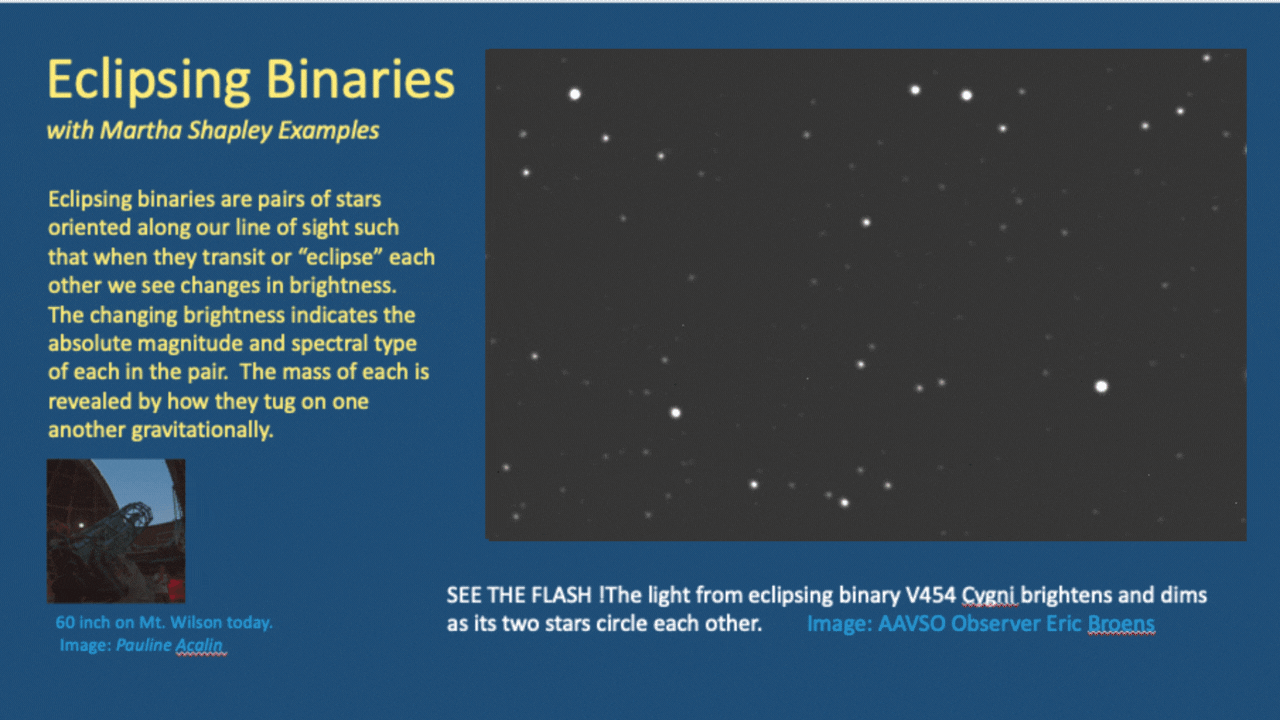
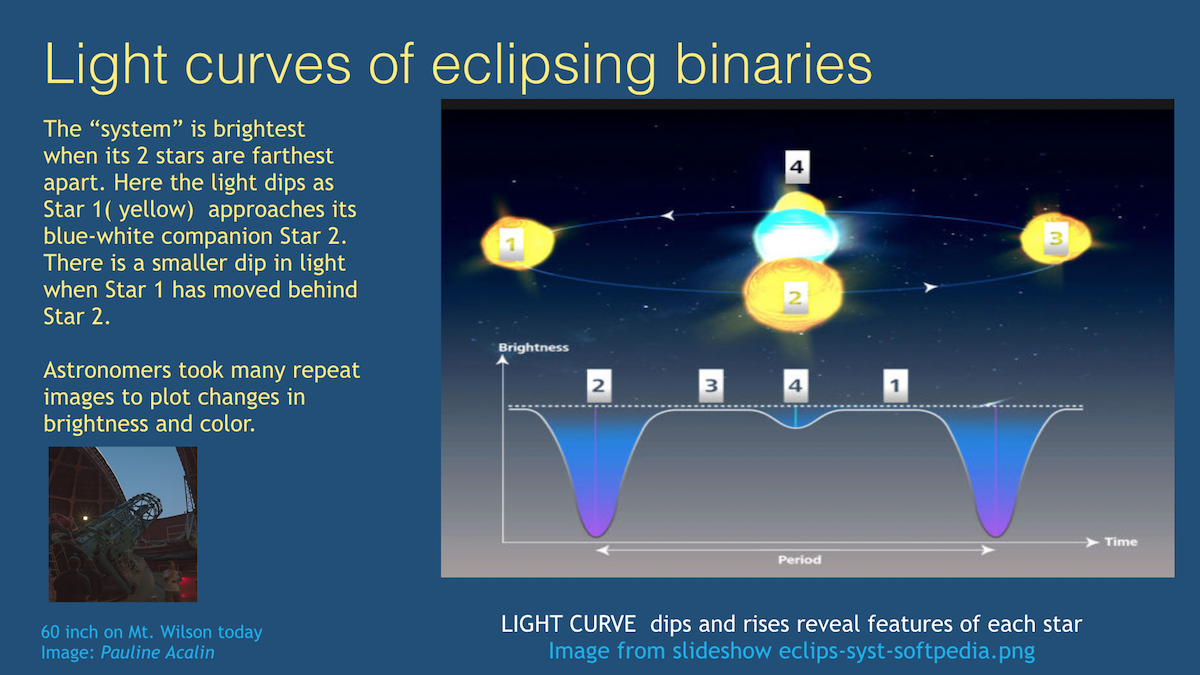
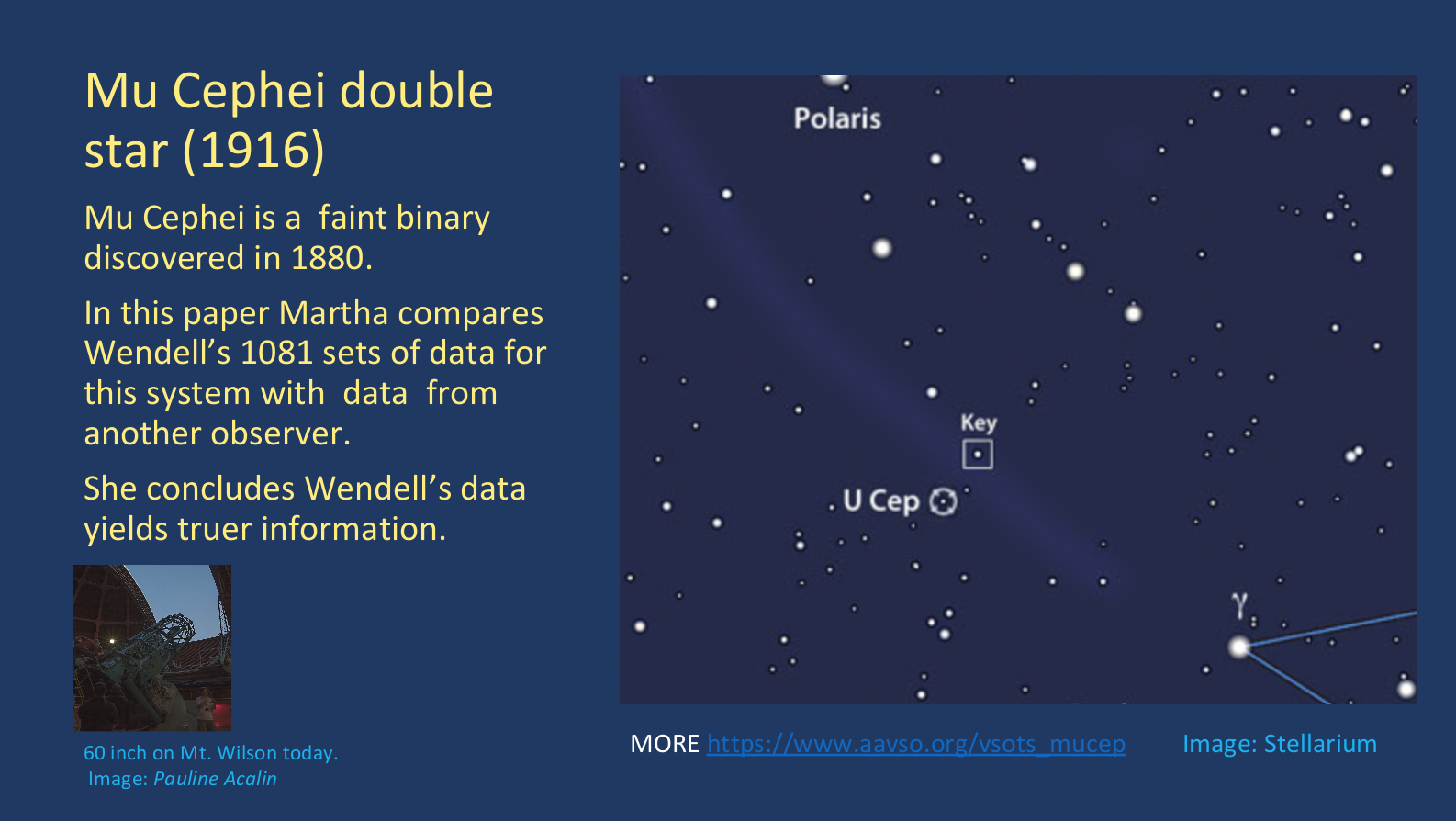
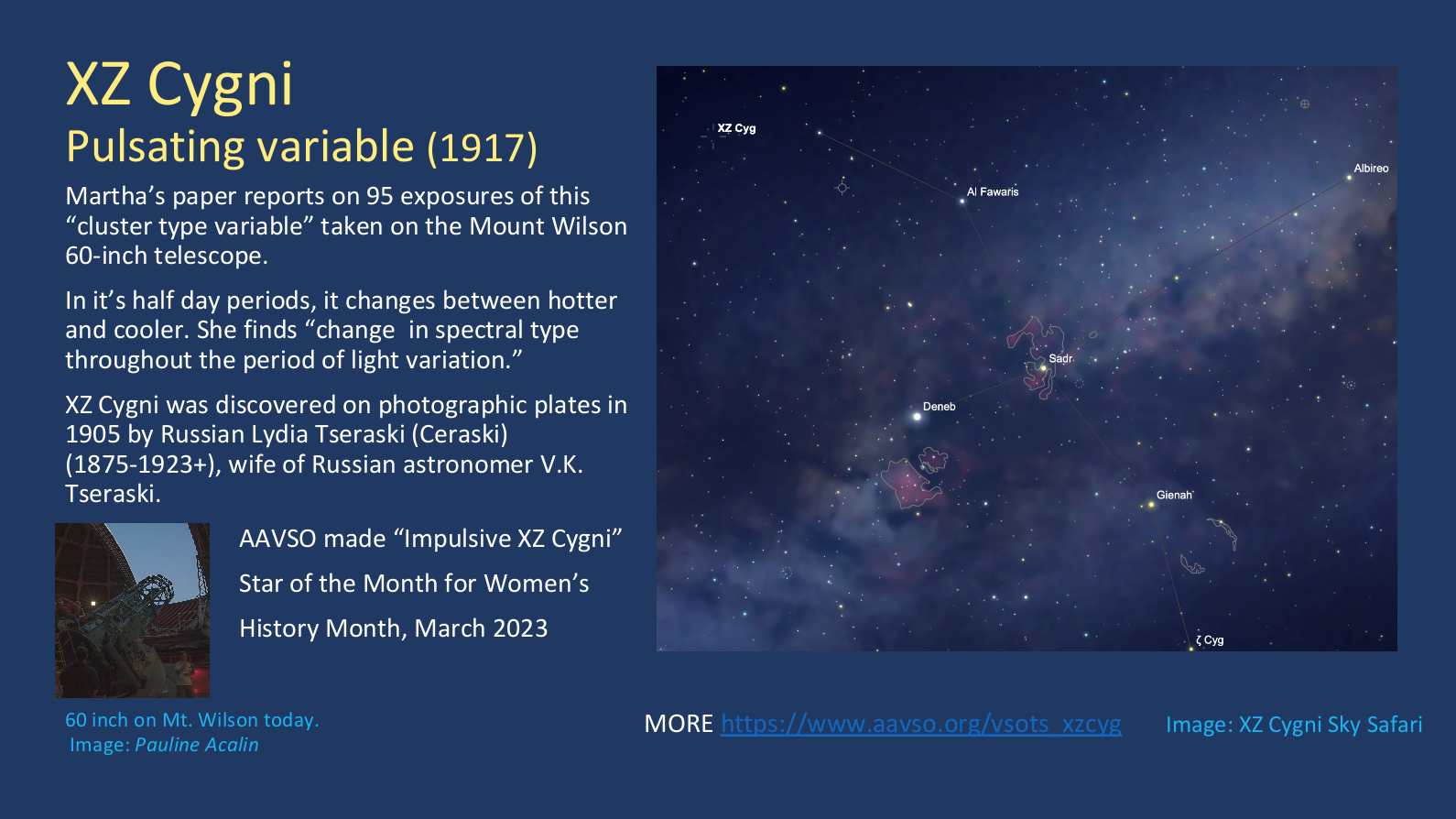
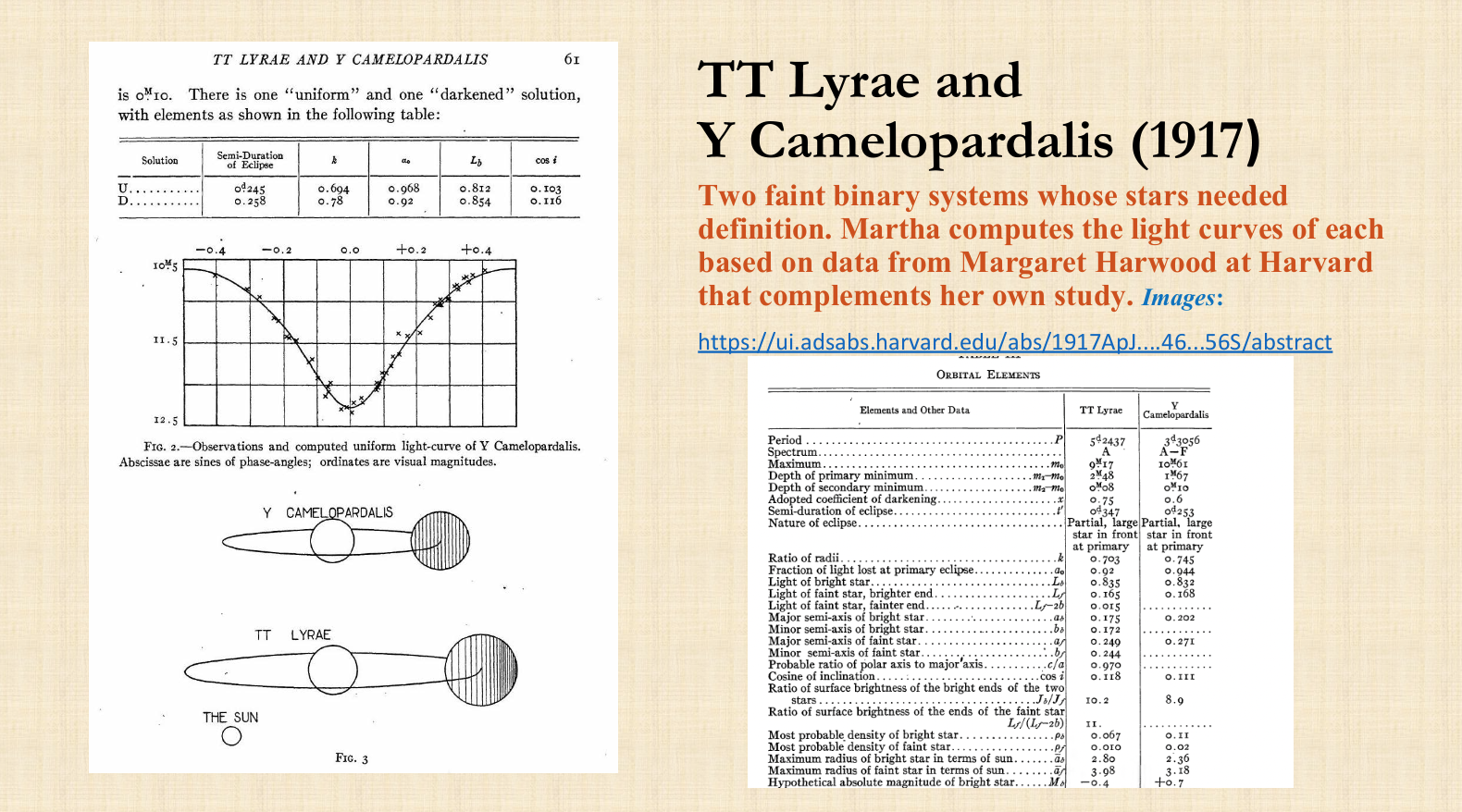
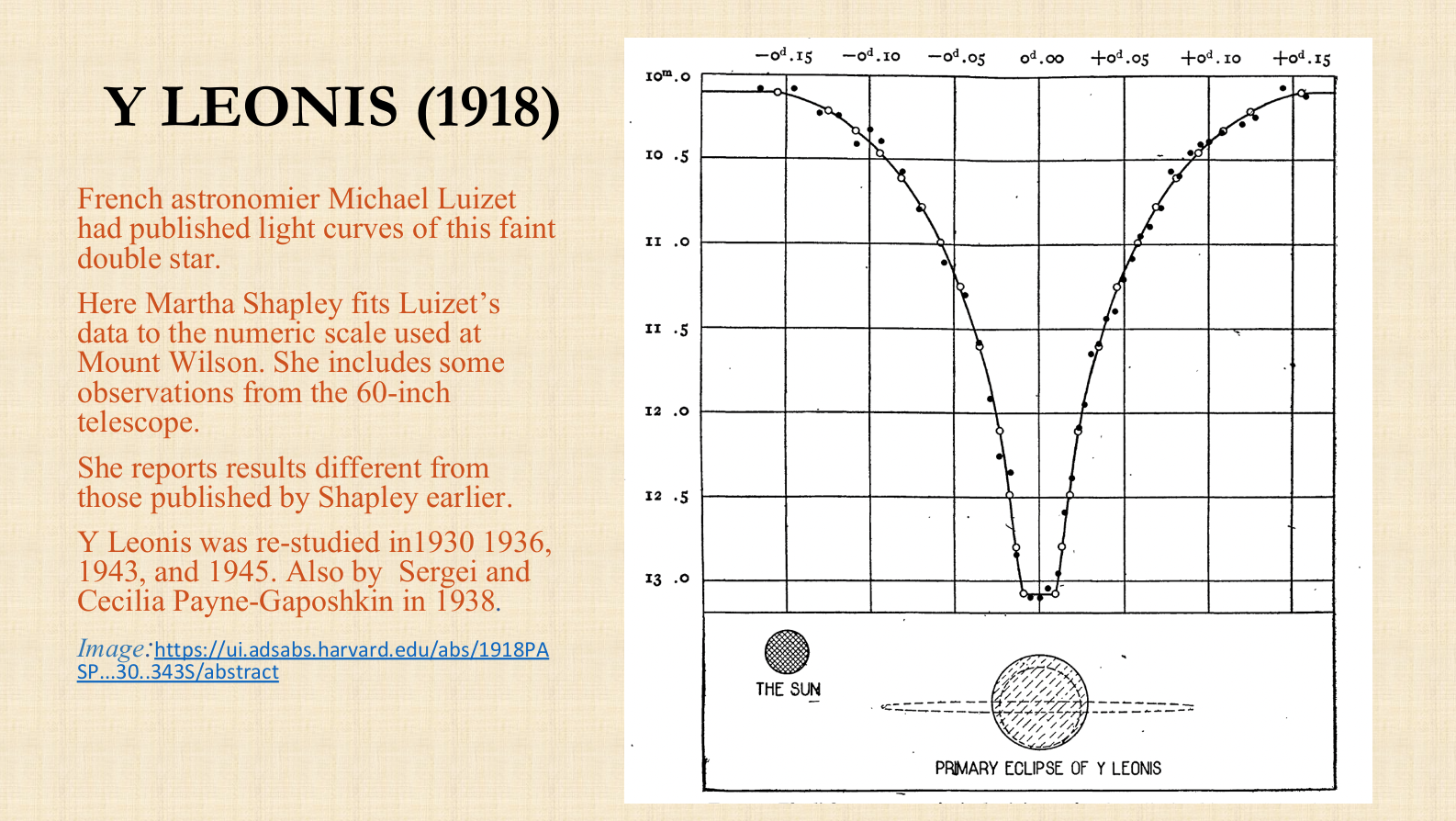
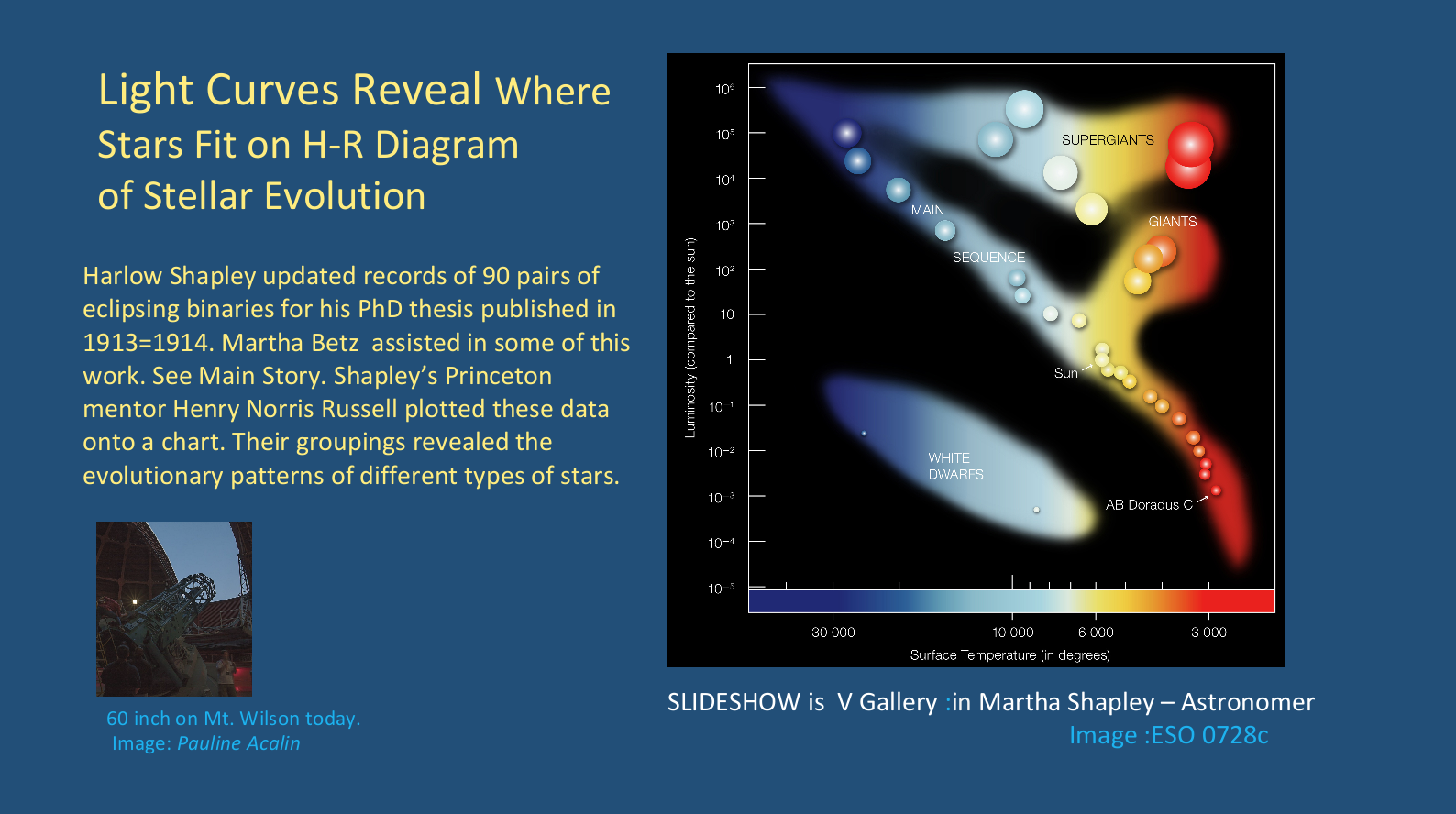
# 13 MARTHA BETZ SHAPLEY BIBLIOGRAPHY BACK TO STORY ⥣
Bibliography [PDF]
Sources:
Part I - Mathshistory.st-andrews.ac.uk/biographies/Shapley-Martha; Annette Betz, Home Life of Carl Betz and Louise Wittig Betz and their Children (1981); Annette Betz, Betz-Wittig Genealogy 1965) (Shapley Collection); Shapley, Harlow, Through Rugged Ways to the Stars (1969), Matthews, Mildred Shapley, Shapley’s Round Table (2021).
Part II - Shapley, Rugged, op cit; DeVorkin, David H. Henry Norris Russell: Dean of American Astronomers (2000); Kopal, Zdeněk, Of Stars and Men: Reminiscences of an Astronomer (1986); Harvard University Archives HUG 4773.55 Harlow Shapley Papers, Martha Shapley Technical Papers 1910-1973; Sandage, Allan, Centennial History of the Carnegie Institution of Washington, Volume I The Mount Wilson Observatory (2004); Shapley’s list of astronomical contributions is Matthews, Shapley’s Round Table, pp. 243, 244.
Part III - Martha Shapley papers - Full citations are in Martha Shapley Bibliography. Bibliocodes are: XX Cygni Cygni 1915ApJ....42..pdf; U Cephei U Cephei 1916ApJ....44…pdf; XZ Cygni 1917CMWCI.128... and 1917ApJ....45. TT Lyrae & Camelopardalis TT Lyrae&Camel_1917ApJ....46…pdf ; Y Leonis 1918PASP...30..343S ; Shapley, Harlow Paper VI is 1918ApJ....48…pdf Quote page 92; Paper X is 1918CMWCI.155....pdf; Paper XII is 1918CMWCI.157....pdf; Paper XIII is 1919CMWCI.160... ; Paper XIV is 1919CMWCI.161... Zone of avoidance and other issues are at Sandage History. Harwood letter is in Sobel, Dava, Glass Universe (2016). Nicholson and Shapley discovery of Asteroid Mildred 878 Bibcode:1917AJ.....30..127S. doi:10.1086/10419; Shapley, Rugged.
Part IV - Ahn, Eun-Joo “Women Scientists at Mount Wilson Observatory during the Early Years: Louise Ware & Jeanne Belle Lasby,” Reflections, Fall 2022 pp. 2, 4,5,6. History: https://www.mtwilson.edu/about-mwo/ ; Voller, Ron Interviews June 15, 2022 and March 24, 2023. Emails April 9 ; Ahn Eemail April 1; Shapley: her “instinct” for mathematics is in Rugged. Duncan visits Martha: Matthews, Shapley’s Round Table.
Complete endnotes (36) available upon request.














